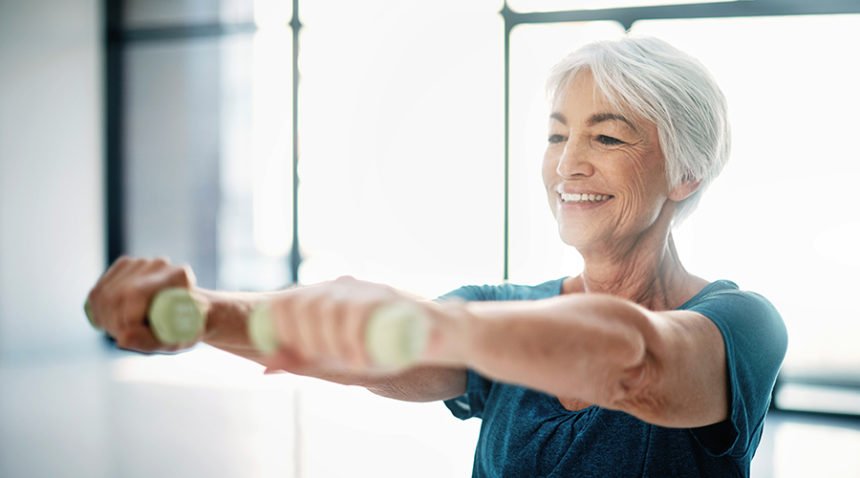At least 1 in 4 women older than 65 have osteoporosis, a disease that weakens bones. It can affect men, too; overall, more than 53 million people in the United States have osteoporosis or are at high risk because of low bone mass.
Fortunately, having a prevention plan can make a huge difference in achieving strong bones and protection against painful fractures.
UNC Health endocrinologist Janet Rubin, MD, explains what osteoporosis is and simple steps you can take to ward off bone loss.
What Is Osteoporosis?
Osteoporosis is a medical condition in which bones become weak and are more likely to break.
“Low bone mass can cause the bone to become more fragile, making it more susceptible to fracture,” Dr. Rubin says.
Osteoporosis is considered a silent disease because bone loss occurs without symptoms. Breaking a bone is often the first sign of osteoporosis. These breaks are most likely to occur in the hip, pelvis, spine or wrist, but other bones can break, too. When the disease affects the spine, it can lead to a stooped or hunched posture.
Osteoporosis Risk Factors
Osteoporosis is most often seen in older women. That’s because of the life cycle of the human skeleton: In childhood and adolescence, new bone is added where needed as old bone is resorbed (gradually broken down). People typically reach peak bone mass once they approach their 30s, Dr. Rubin says.
As people enter their 50s, there is an increase in bone resorption and a reduction in bone formation. This process of bone resorption outpacing bone formation is part of the normal aging process, and it results in weaker bones with a higher risk of fracture.
“Aging is associated with increased breakdown of bone with a failure to replace this bone, so the bone thins. Our bodies are always repairing bone, but we just don’t do it as well when we are old as when we are young,” Dr. Rubin says.
Women are at higher risk of skeletal fragility because they generally have smaller bones than men. After menopause, they lose the benefit of estrogen, a female hormone that helps maintain bone mass. Thin people with small frames are at higher risk of osteoporotic fractures, and genetics play a significant role.
“Bone density is 80 percent genetic. If your mother has osteoporosis and your older sister has osteoporosis, you’re more than likely going to have it, too,” Dr. Rubin says.
Long-term use of certain medications can lead to loss of bone density and fractures.
“Certain kinds of drugs can cause osteoporosis, like steroids. People who take prednisone for rheumatoid arthritis, asthma or Crohn’s disease are more likely to have osteoporosis. Prednisone itself causes degradation of bone,” Dr. Rubin says.
Drugs used to treat breast and prostate cancers, lupus and diseases of the lungs, kidneys and liver also can contribute to bone loss.
How to Prevent Osteoporosis
To keep your bones healthy and strong, there are easy, practical ways to strengthen and help build new bone tissue.
1. Exercise daily.
Exercise helps to strengthen your muscles and improves your balance. Dr. Rubin recommends weight-bearing and resistance exercises, core and upper-body workouts, walking, jogging or playing a sport.
“If you want to stay mobile until your late 80s, you have to work at it. Exercise helps maintain bone density,” Dr. Rubin says. “The stronger you are, the bigger your bones will be, which is great to fight against osteoporosis.”
2. Include calcium and vitamin D in your diet.
A lack of calcium and vitamin D can contribute to the development of osteoporosis. During your meals, try to include food sources rich in calcium; try low-fat dairy products such as milk, yogurt and cheese. Don’t forget dark green leafy vegetables, too, such as broccoli, collard greens and spinach.
Food sources with vitamin D include egg yolks and fish, such as salmon, tuna or mackerel. You can talk to your doctor about whether you’re getting enough calcium and vitamin D, and whether you should take a supplement.
3. Don’t smoke, and limit alcohol use.
Tobacco and nicotine are harmful for your bones. Studies have shown a connection between tobacco use and decreased bone density.
Heavy drinking is also linked to decreased bone density, and it can lead to falls and potential bone fractures. Both alcohol consumption and tobacco use have subtle detrimental effects on the skeleton and increase fracture risk, Dr. Rubin says.
4. Ask your doctor for a bone mineral density test.
A bone mineral density test is a great option to know whether you have osteoporosis. The test involves an X-ray over specific areas of the body, such as the hip or lower spine, to check for weak bones. The test will help determine your risk of fractures and measure your response to osteoporosis treatment.
“A woman should have a bone mineral density test (a DEXA scan) in her 60s to help determine her risk for fracture. For men, there are recommendations to have the test around age 72, but the recommendation is not as well-supported by data as it is for women,” Dr. Rubin says.
Talk to your doctor about whether you need a bone mineral density test.
5. Make your home safer by preventing falls.
Try to keep your home free from clutter that could lead to tripping and falling. Remove any objects on the floor or items blocking doorways and entrances. Avoid walking on slippery surfaces, such as wet floors.
Visit an eye doctor to check your vision regularly. Being able to see clearly will help you prevent falls.
If you would like to learn more about osteoporosis, talk to your doctor. If you don’t have one, you can find one here.

